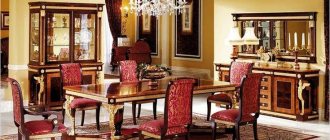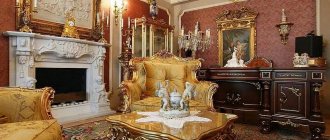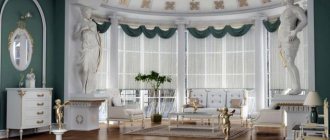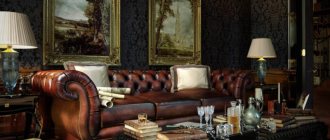History of the origin of the Empire style
We owe the appearance of the Empire style to the famous French Emperor Napoleon the First. It was during his reign that the transition from the era of classicism to a new, more solemn and triumphant trend in art took place.
Napoleon Bonaparte (Jacques Louis David)
It is worth saying that the Empire style incredibly accurately suited the historical period in which it originated, the period of great conquests, great wars, huge armies and majestic empires.
The name "empire" comes from the French word "empire" - empire.
The second country where the new movement in art became widespread, oddly enough, was the Russian Empire, the main enemy of France during the Napoleonic Wars. It got its start in the second half of the reign of Alexander the First. The construction of the Mikhailovsky Palace, the building of the Moscow Bolshoi Theater, the Gagarin Estate and other objects belong to this period.
Alexander the First (portrait of George Doe)
However, the “Russian Empire” received its main development during the reign of Nicholas I.
The main features of the Empire style
An obligatory feature of the “imperial style” is an appeal to the culture of ancient Rome, ancient Greek city-states and other states of the Hellenistic era. The Empire style often uses elements that emphasize power, military superiority, and state power. It is no coincidence that this trend in art flourished during a period of strong states and the enormous importance of the armed forces of the countries.
Altar of Peace (art of ancient Rome)
The Empire style has found its place in various branches of human activity. Many artists, sculptors, fashion designers and designers often use elements of the 19th century era in their works to give them a special look, aesthetics and significance.
Mastermind
Empire style became the final stage of classicism
, which we wrote about not so long ago. After the bourgeois revolution, Napoleon I came to power and became not only a serious political figure, but also an object of inspiration for artists. They reflected his courage and valor in painting and design, exterior and interior, and each of his campaigns, be it an Italian or an Egyptian campaign, was reflected in design and architecture.
The military glory of the emperor was extolled mainly through symbols, special signs and emblems. For example, laurel wreaths, torches, eagles and trophies were often used. And the furniture was decorated with images of lions and caryatids
, sphinxes and various mythical creatures, each of which carried a semantic load. Thus, lions and eagles signified strength, courage and courage, and the swan, on the contrary, grace and sophistication. Napoleon himself had a distinctive sign - a bee - the oldest symbol of French independence. It was this symbol that was embroidered with gold threads on textiles and placed wherever the visitors’ eyes fell.
Empire style in architecture
The “imperial style” gained particular popularity in architecture, where it is characterized by the following features:
- The presence of columns, stucco, antique sculptures and strict lines.
- The symmetry of the elements must be strictly observed and balance must be maintained.
- Rich decorations, military elements, massiveness and monumentality.
Probably the most famous architectural structure erected in this era is the Arc de Triomphe in Paris.
Arc de Triomphe in Paris
In 1806, by order of Napoleon Bonaparte, construction of this monumental structure began. The work lasted for 30 years and was carried out under the leadership of three architects, however, F. Chalgrin was considered the main one.
Art historians consider the Roman Arch of Titus to be the prototype of Chalgrin's work.
Arch of Titus in Rome
The Vendôme Column is an equally monumental and significant structure of the Napoleonic era. The creators of this column are J. B. Leper and J. Gondoin. The work was done in honor of the victories of the French Emperor and the Trojan Column was taken as its basis. Here you can also trace the appeal to the themes of antiquity and military achievements.
In the Russian Empire, the most famous architect of the Empire style is considered to be Carl Rossi, the author of the projects of the Mikhailovsky Palace, Palace Square and the General Staff building.
Main headquarters building in St. Petersburg
However, we should not forget such famous people as: A. Zakharov, D. Gilardi, O. Montferan.
Admiralty building designed by Zakharov
I. Martos is considered the main sculptor of the Russian Empire style. Ivan Petrovich put his hand to the following historical sculptures: the monument to Minin and Pozharsky on Red Square, the monument to Alexander I in Taganrog, as well as the bronze statue of John the Baptist on the portico of the Kazan Cathedral in St. Petersburg. Sailor's works are of particular value for Russian culture and are a national treasure.
At the end of the 40s of the 19th century, a new approach to creativity came to replace it - historicism. In the 1930s, a “rehabilitation” of this architectural style was carried out in the form of the so-called “Stalinist Empire”, which acquired the features of Russian constructivism
The Chkalov staircase in Nizhny Novgorod as an example of Stalinist Empire architecture
The building of Moscow State University is an example of the Stalinist Empire style
Instead of sophistication and subtlety
With the advent of the Empire era, art became larger-scale and monumental. At the same time, the exquisite subtlety in the style of Louis XVI is replaced by excessive rationality with pomp and even pathos. In the desire of the bourgeoisie, which had won and abandoned the “royal” direction, to imitate the life or customs of the ancient Romans, there was much that was theatrical or ostentatious. In some European countries, the aristocracy and the big bourgeoisie, for whom French classicism from the time of Louis XVI had recently been a role model, began to openly follow the imperial style.
After the revolution in Paris, numerous artists and architects again gathered from different places and chose to work in this new style. Empire style in architecture, examples of buildings of which did not resemble the more “collected” classicism, unlike previous trends, had a fairly cosmopolitan character, which, due to its regulation, precluded the creation of local schools. However, this did not prevent the birth of a Russian version of this style after some time.
Empire style in painting
The main representative of the Empire style in painting is the French painter Jacques Louis David.
His main works are: “Napoleon at the Saint Bernard Pass” and “Portrait of Madame Recamier”.
Bonaparte at the Saint Bernard Pass. Jacques Louis David
Paintings in the Empire style are characterized by the following features:
- majesty,
- pride, antique moods,
- aesthetics of war and victories.
Portraits of women in Empire style paintings are full of majesty and imperial pride. Such paintings depicted representatives of the upper classes.
Materials
Empire style is rich in expensive, natural materials: precious wood, marble, bronze, leather. The walls and floor, in addition to their functional meaning, also have a decorative meaning, as do all Empire style surfaces. Thus, expensive textiles, brocade and silk are used to decorate the walls.
Natural materials here are not a recommendation, but a requirement. Furniture made from precious mahogany pores, upholstery made from genuine leather and textiles embroidered with gold threads are in fashion. Also, gilding of individual interior elements does not lose popularity.
Empire style in the interior
Main features
“Imperial style” is also ideal for arranging interior decoration. An Empire style interior should have the following features:
- Expensive and luxurious decor;
- Elements of classical architecture (columns, pilasters, stucco moldings, sculptures);
- The presence of ancient culture (images of animals, warriors, etc.);
- Gold, bronze colors. Metal inserts, paintings and antiques;
- Eclecticism.
Previously, only representatives of the upper class could afford to decorate housing according to the patterns of late classicism. Empire style requires large space and “imperial” scope. Therefore, the rooms need to be large and spacious, with wide windows and high ceilings.
Often, living rooms and bedrooms are decorated in the Empire style to emphasize the high status and financial position of the owner of the house. These rooms are ideal for decoration in this style.
Living room design example
When creating an interior, massive furniture with metal inserts, decorative legs and expensive decor is used. Particularly important elements are the luxurious chandelier and wall decor.
Empire style bedroom
The end of the era of classicism
The sources for the creative inspiration of architects were the art of Ancient Greece in the archaic period and Ancient Rome in the late period of the empire, combined with the culture of Etruria, Ancient Egypt and other civilizations. Plastic ideas of ancient Egyptian architecture, undivided large surfaces of walls with massive columns and pylons, providing clarity with geometric correctness of solid volumes, etc. - all this distinguished the Empire style. The architecture of the 19th century became the personification of laconicism, monumentality and strict balance and symmetry of parts. This time is called the period of establishment of military glory and imperial greatness, realized through numerous symbols and signs. In the decorative decoration of the interiors and exteriors of buildings, in furniture, as well as in lamps and utensils, symbols of military glory and emblems were used in large quantities, borrowed from ancient Roman decorative means in the form of trophies and laurel wreaths, announcer bundles and eagles, torches and the often repeated letter N .
Such exotic decor only enhanced the theatricality of the interior. Examples of Empire style in architecture, according to experts, very clearly characterize the direct borrowing of certain types and forms from the object world of antiquity. For example, triumphal arches and memorial obelisks were built and decorated accordingly.
Empire style in graphic and web design
With the development of technology and the Internet, many areas of art began to flow into the computer sphere. Empire style was no exception. Today, designers often resort to this type of design to highlight their work in the market.
First of all, it is worth saying that such a design is not suitable for every project.
For example, for pages of official government structures, museums, banks, historical sites and galleries, the Empire style would be the best choice.
Tinkoff's corporate identity is designed in an empire style
Empire style design primarily expresses the premium and prestige of the represented brand.
Bar logo design for the premium segment
Colors and shapes
You should not use a large number of colors, it is better to focus on two of the following basic shades:
- gold,
- emerald,
- dark blue,
- red
- white colors
They are most consistent with this type of design and create a special atmosphere.
The use of military paraphernalia, images of sculptures of Ancient Rome, mythological motifs - all this is welcome when creating graphic or web design with Empire elements.
Logo with military paraphernalia
But most often the Empire style in graphic design is expressed in the use of antique patterns and geometric textures.
An example of a texture from an antique pattern
Vignette design in Empire style
Fonts
The font is extremely important. When designing, you must use only strict fonts, without unnecessary elements or embellishment.
It is worth using bold lines to emphasize particularly important points in the text; this gives the text special significance and indicates a serious attitude towards cooperation or work.
Empire style typography example
For headings and logo elements, graphic fonts with features characteristic of the entire Empire style can be used.
An example of a graphic font in the Empire style
The final “chord” of the Russian Empire style
Empire style architecture, examples of which can be seen most in Russia in St. Petersburg, clearly expresses the mood of that time. The apotheosis of this Russian trend is St. Isaac's Cathedral. It was built in 1858 according to the design of O. Montferrand. The simplest forms prevail in it: a cube with a square, a triangle, a cylinder and a parabolic dome, which, in addition to its large size, gave the temple some additional monumentality and created the impression of imperial centuries-old inviolability. During the construction of the cathedral, progressive technical solutions of that time were used: a continuous slab grillage made of stone masonry, cast iron ribs on the domes, columns made of solid granite monoliths. The rich exterior decor with colorful interiors is also striking.
Empire style in fashion
Empire style is often used in modern fashion, by representatives of both sexes. Most often, clothes in this style are worn on special occasions, but sometimes in everyday life.
Typically, the “imperial outfit” is chosen by people who want to emphasize the elegance of their body, love of aesthetics and efficiency.
Often the person who dresses like this is very calm and cold, he is not used to tolerating inconvenience and ignorance. Secular ladies and their husbands often turn to the era of the 19th century when choosing a costume, to the images of commanders and ladies-in-waiting of that era.
19th century dress in Empire style
Empire style corduroy dress
Women's attire of this era is particularly luxurious. Almost always this is a dress with bare shoulders, a deep neckline, gold inserts, a high waist, sparkles and rhinestones. These features are also inherent in modern fashion.
Empire style dress (Broke Collection – Vogue)
Sheer Empire lace dress (Broke Collection – Vogue)
Empire style dresses are also light and elegant at the same time.
Elegant black dress in Empire style
Interpreted for every day, empire style dresses most often have a Greek silhouette.
Empire style dress in business style
Light romantic dress with Empire silhouette
The essence of empire style in modern fashion is considered to be the white dress of the bride at a wedding.
Empire style wedding dress
Egyptian motifs
In 1797, Napoleon made a campaign in Egypt, and almost immediately everything oriental came into fashion - sphinxes, ibises, hieroglyphs.
Particularly popular are stools with crossing legs, decorated with bronze, as well as three-legged stools found during excavations in Pompeii.











